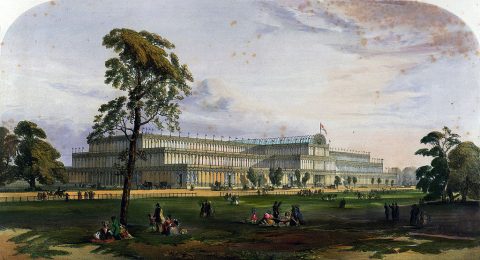Mustard
Published 10 Sep 2020Sign up for an annual CuriosityStream subscription and you’ll also get a free Nebula subscription (the new streaming platform built by creators) here: http://CuriosityStream.com/mustard
Research and writing in collaboration with Tomás Campos.
The Soviets built some of the largest and most technically advanced helicopters in the world. By 1957, the Mil Mi-6 had already emerged as the largest helicopter ever built, far out-sizing helicopters built in the west. But for the Soviet Union, the need to build a helicopter far larger than even the Mi-6, soon became a matter of national security.
By 1960, American U-2 spy planes conducting high altitude reconnaissance flights over the Soviet Union were beginning to uncover the location of the country’s Intercontinental Ballistic Missile (ICBM) sites. These first generation R-7 Semyorka ICBMs were being deployed throughout the Soviet Union as fast as possible, but their enormous size and weight meant they could only be delivered to launch sites using trains. The need to build rail lines to launch sites made the ICBM sites easy to spot in U.S. reconnaissance photos.
Keeping the missile sites hidden was a matter of national security. The Soviets devised a bold plan to airlift ICBMs into the vast and remote Soviet wilderness, thereby eliminating the need for rail lines or even roads. This would make it virtually impossible for spy planes to track down missile sites hidden in over twelve million square kilometres of forests. But to make the plan work, the Soviets would need to build a helicopter with at least twice the lifting power of the Mi-6.
Design studies for the new enormous helicopter began in 1959, with the Soviet Council of Ministers formally approving development in 1962. But development of such an ambitious helicopter would progress slowly, as various configurations (single rotor, tandem and transverse) were studied. Construction of testing-rigs, transmission systems and mock-ups began in 1963, and construction of the first prototype started in 1965. The new prototype would be designated as the Mil V-12 (with plans to designate the production version as Mil Mi-12). The first test flight in 1967 ended in failure as the V-12 crashed back to earth sustaining minor damage due to oscillations caused by control problems. A second test flight a year later proved the helicopter’s airworthiness.
The V-12 would go on to break numerous world records for lifting capacity, but its fate had already been sealed by a rapidly changing strategic situation. The introduction of spy satellites, and the development of new lighter and mobile ICBMs made hiding nuclear missiles strategically irrelevant.
In 1970, the Soviet Air Force refused to accept the V-12 into state acceptance trials, due to a lack of need. Although a second V-12 prototype would be constructed in 1972, there were simply too few scenarios that would require such a large and complex helicopter. In 1974 development of the V-12 was cancelled and the Mil Design Bureau shifted efforts to designing the Mil Mi-26, the largest helicopter to enter service.
Select footage courtesy the AP Archive:
AP Archive website: http://www.aparchive.com YouTube: https://www.youtube.com/c/aparchive and https://www.youtube.com/c/britishmovi…Special thanks to Nick Arehart for helping clean up our audio:
https://twitter.com/airhrt_Link to the Mustard Store:
teespring.com/stores/mustard-storeMusic used in this production (reproduced under license):
Intro Song: “Space Cinematic”- https://www.pond5.com/royalty-free-mu…
Song 2: “Yet Another Chase” – https://www.epidemicsound.com/track/X…
Song 3: “The Board Is Set” – https://www.epidemicsound.com/track/g…
Song 4: “Grim March” – https://www.pond5.com/royalty-free-mu…
Song 5: “Like the Wind” – https://www.pond5.com/royalty-free-mu…
Song 6: “Synthwave Industrial Technology” – https://audiojungle.net/item/synthwav…
Thanks for watching!
April 24, 2021
This Insane Helicopter Was The Largest Ever Built: The Mil V-12 Story
April 17, 2021
“Today’s Liberal government is […] the most anti-Internet government in Canadian history”
Michael Geist gives both barrels to Justin Trudeau’s government, then reloads and fires again:
As I watched Canadian Heritage Minister Steven Guilbeault yesterday close the Action Summit to Combat Online Hate, I was left with whiplash as I thought back to those early days. Today’s Liberal government is unrecognizable by comparison as it today stands the most anti-Internet government in Canadian history:
- As it moves to create the Great Canadian Internet Firewall, net neutrality is out and mandated Internet blocking is in.
- Freedom of expression and due process is out, quick takedowns without independent review and increased liability are in.
- Innovation and new business models are out, CRTC regulation is in.
- Privacy reform is out, Internet taxation is in.
- Prioritizing consumer Internet access and affordability is out, reduced competition through mergers are in.
- And perhaps most troublingly, consultation and transparency are out, secrecy is in.
This is not hyperbole. The Action Summit is a case in point. I was part of the planning committee and I am proud that the event produced two days of thoughtful discussion and debate, where the both the importance and complexity of addressing online hate brought a myriad of perspectives, including from the major Internet platforms. There was none of that nuance in Guilbeault’s words, who spoke the evil associated with the “web behemoths” and promised that his legislation would target content and Internet sites and services anywhere in the world provided it was accessible to Canadians. The obvious implications – much discussed in Internet circles in Ottawa – is that the government plans to introduce mandated content blocking to keep such content out of Canada as a so-called “last resort”. When combined with a copyright “consultation” launched this week that also raises Internet blocking, Guilbeault’s vision is to require Internet providers to install blocking capabilities, create new regulators and content adjudicators to issue blocking orders, dispense with net neutrality, and build a Canadian Internet firewall.
If that wasn’t enough, his forthcoming bill will also mandate content removals within 24 hours with significant penalties for failure to do so. The approach trades due process for speed, effectively reducing independent oversight and incentivizing content removal by Internet platforms. Just about everyone thinks this is a bad idea, but Guilbeault insists that “it is in the mandate letter.” In other words, consultations don’t matter, expertise doesn’t matter, the experience elsewhere doesn’t matter. Instead, a mandate letter trumps all. If this occurred under Stephen Harper’s watch, the criticism would be unrelenting.
In fact, one of the reasons that the government finds itself committed to dangerous policy is that it did not conduct a public consultation on its forthcoming online harms bill. Guilbeault was forced yesterday to admit that the public has not been consulted, which he tried to justify by claiming that it could participate in the committee review or in the development of implementation guidelines once the bill becomes law. This alone should be disqualifying as no government should introduce censorship legislation that mandates website blocking, eradicates net neutrality, harms freedom of expression, and dispenses with due process without having ever consulted Canadians on the issue.
March 25, 2021
QotD: Lucas, the Prince of Darkness
Joe Lucas — or, more accurately, the company bearing his name — engineered electrical bits for pretty much everything emanating from the UK, and the notorious unreliability of Lucas components played a key role in tanking the British car industry in the early 1980s. Make the jump for “If Lucas made guns, wars would not start,” and other classics.
- The Lucas motto: “Get home before dark.”
- Lucas is the patent holder for the short circuit.
- Lucas — Inventor of the first intermittent wiper.
- Lucas — Inventor of the self-dimming headlamp.
- The three position Lucas switch — Dim, Flicker and Off.
- The Original Anti-Theft Device — Lucas Electrics.
- Lucas is an acronym for Loose Unsoldered Connections and Splices
Andrew Stoy, “Joe Lucas, Prince Of Darkness: British Electrical System Jokes”, Jalopnik, 2008-08-04.
March 20, 2021
Iron cannon, improved celestial navigation techniques, and “race-built” galleons
In the latest Age of Invention newsletter, Anton Howes considers some of the technological innovations which helped English sailors to overcome powerful adversaries of the Spanish and Portuguese navies in the late 1500s and early 1600s:

Stern view of a model of the Revenge as an example of a race-built galleon, 1577.
Image from modellmarine.de
Apart from the adoption and refinement of celestial navigation techniques, however, English seafaring capabilities also benefited from some more obvious, physical changes. In 1588, for example, on the eve of the Spanish Armada, a senior Spanish officer believed that the English had “many more long-range guns”. By the 1540s, medieval ironmaking techniques involving the blast furnace had gradually spread from Germany, to Normandy, and thence to the Weald of Sussex and Kent. Whereas in the first half of the sixteenth century England had typically imported three quarters of its iron from Spain, by 1590 it had not only quintupled its consumption of iron but was also almost entirely self-sufficient. And by allowing England to exploit its plentiful domestic deposits of iron, the blast furnace resulted in it producing many more cheap cannon.
Iron guns were in many ways worse for ships than those of bronze. They were heavier, prone to corrosion, and more likely to explode without warning. Bronze guns, by contrast, would first bulge and then split, but in any case tended to last. When the British captured Gorée off the coast of Senegal in 1758, they found a working English-made bronze cannon that dated from 1582. Yet iron was only 10-20% the price of bronze. Although the Royal Navy for decades continued to prefer bronze, cheap, medium-sized cannon of iron proliferated, becoming affordable to merchants, pirates, and privateers — a situation that was unique to England.
English ships were thus especially well-armed, allowing them to access new markets even when they sailed into hostile waters. They were soon some of the only merchants able to hold their own against the latest Mediterranean apex predator, whether it be the Spanish navy, Algeria-based corsairs, or Ottoman galleys. And they were able to insert themselves, sometimes violently, into the inter-oceanic trades — all despite the armed resistance of the Spanish and Portuguese, who had long monopolised those routes. In the 1560s, John Hawkins tried a few times to muscle in on the transatlantic Portuguese and Spanish trade in slaves. With backing from the monarch and her ministers, he captured Portuguese slave ships, raided and traded along the African coastline himself, and then sold slaves in the Spanish colonies of the Americas, sometimes having to attack those colonies before the local governor would allow them to trade. (The attempt was ultimately unsuccessful, as Hawkins’s privateering fleet was all but destroyed in 1568 and the English were not involved in the slave trade again for almost a century.)
The English hold over the hostile markets was only threatened during times of peace on the continent, when their ships’ defensiveness no longer gave them a special advantage. The Dutch usurped English dominance of the trade with Iberia and the Mediterranean, for example, during the Dutch Republic’s truce with Spain 1609-21. Their more efficient ships, especially for bulk commodities — the fluyt invented at Hoorn in the late 1580s — were cheaper to build, required fewer sailors, and were easier to handle. But these advantages only made them competitive when the risk of attack was low, as they were hardly armed. When wars resumed, the English had a chance to regain their position.
Finally, the English acquired a few further advantages when it came to ship design. Thanks to the shipwright Matthew Baker, who had been on the trial voyage Cabot dispatched to the Mediterranean, England experienced a revolution in using mathematics to design ships. Baker’s methods, seemingly developed in the 1560s, allowed him to more cheaply experiment with new forms, and by the 1570s these began to bear fruit. The old ocean-going carracks and galleons, with their high forecastles and aftercastles, became substantially sleeker. Taking inspiration from nature, Baker designed a streamlined, elongated hull modelled below the waterline upon a cod’s head with a mackerel tail. Above the waterline, too, he lowered the forecastle and set it further back, as well as flattening the aftercastle.
Starting in 1570 with his prototype the Foresight, and more fully developed in 1575-77 with the Revenge, these razed or “race-built” galleons gave the English some significant advantages. Drake even chose the Revenge as his flagship to battle the Spanish Armada in 1588, and to lead an ill-fated reprisal invasion of Portugal the following year. The higher castles of carracks and old-style galleons were suited to clearing an enemy’s decks with arrows and gunfire, as well as to defend against boarders. They were designed for combat at close quarters, in which height was an advantage. They were floating fortresses, their imposing height known to inspire terror. The race-built galleons, by contrast, by making the ship less top-heavy, could have longer and lower gundecks, with more of the ship’s displacement devoted to ordnance — especially useful when taking advantage of the cheaper but heavier cannon made of iron. Rather than killing an enemy ship’s sailors and soldiers, the race-built galleons were optimised for blasting through its hull. What they lost in “majesty and terror”, they made up for with overwhelming firepower. They aimed to sink.
March 11, 2021
QotD: Microsoft PowerPoint
There were plenty of irritations with life with Microsoft. I am still astonished how bad PowerPoint is from a design point of view. With these multiples, Microsoft could have hired Louise Fili or Milton Glazer, and the virtual world of the corporation would now be vastly more visual. Actually, because form is content, America would now actually be vastly more conceptual. But, no. The PowerPoint templates were clearly designed by that special someone who did Travelodge napkins and match books in the 1960s. Talk about a difference that makes a difference! Talk about critical path dependency! PowerPoint reproduced Microsoft’s limitations, and helped to install them in the American mind.
Still, PowerPoint was an improvement on the Lotus equivalent. I forget what this was called but it was so utterly unpredictable that I discovered belatedly that presentations would not be forthcoming unless you got a group of people to lay their hands on the printer and chant in Latin. (This was not in the manual, unless it was cunningly secreted there in invisible ink, perhaps on the page that read “this page left deliberately blank.”)
Grant McCracken, “Brands that bind … and when they slide”, This Blog Sits at the, 2005-03-10
February 27, 2021
QotD: What the instructions in Haynes manuals really mean
Haynes: Should remove easily.
Translation: Will be corroded into place … Clamp with adjustable spanner then beat repeatedly with a hammer.Haynes: This is a snug fit.
Translation: You will skin your knuckles! … Clamp with adjustable spanner then beat repeatedly with hammer.Haynes: This is a tight fit.
Translation: Not a hope in hell matey! … Clamp with adjustable spanner then beat repeatedly with hammer.Haynes: As described in Chapter 7 …
Translation: That’ll teach you not to read through before you start, now you are looking at scary photos of the inside of a gearbox.Haynes: Pry …
Translation: Hammer a screwdriver into …Haynes: Undo …
Translation: Go buy a tin of WD40 (industrial size).Haynes: Ease …
Translation: Apply superhuman strength to …Haynes: Retain tiny spring …
Translation: “Crikey what was that, it nearly had my eye out”!Haynes: Press and rotate to remove bulb …
Translation: OK — that’s the glass bit off, now fetch some good pliers to dig out the bayonet part and remaining glass shards.Do it by the book — the real meaning of Haynes instructions.
February 22, 2021
February 21, 2021
Missing the point of the 1851 Great Exhibition
In the latest Age of Invention newsletter, Anton Howes explains why the 1951 Festival of Britain failed to reproduce the success of the Great Exhibition of a century earlier, even though it did succeed in other ways:

The Crystal Palace from the northeast during the Great Exhibition of 1851, image from the 1852 book Dickinsons’ comprehensive pictures of the Great Exhibition of 1851
Wikimedia Commons.
… the idea that I tend to get most excited about, which I mentioned only in passing last month, is how we might resurrect the spirit of the nineteenth-century exhibitions of industry.
The best-known of these is undoubtedly the Great Exhibition of the Works of Industry of All Nations of 1851, still famous for its Crystal Palace. Held in Hyde Park, London, it attracted six million visitors, and has been emulated many times since. The World Fairs of today number the Great Exhibition as their first. Yet most people today don’t really appreciate what the Great Exhibition was actually for. They see it as a big, international event, with millions of visitors, who saw all sorts of fancy and exciting things — a chance for Britain, and many other countries since, to show off. The result is that many of the events that seek to capture something of the spirit of the original exhibition — 1951’s Festival of Britain, most of the World Fairs since the Second World War, the Millennium Experience, the 2018 Great Exhibition of the North, and now an upcoming “definitely-not-a-Festival-of-Brexit” (currently branded as Festival UK* 2022) — totally and utterly miss the point.
This is perhaps best illustrated by the runup to the 1951 Festival of Britain. Its proposers in the 1940s saw that the centenary of the Great Exhibition was coming up, so they proposed that there should be something similar to mark it. Yet by doing so, they did things entirely back-to-front. The Great Exhibition had a purpose; the exhibition was just the medium. It was the tool for a specific and sophisticated agenda. The Festival of Britain, by contrast, started with the idea of an exhibition, and then flailed about for a reason why. The government had a vague idea of organising an event to lift the country’s spirits after the Second World War, as well as to have it Britain-focused so as to craft a new national identity as the old empire disintegrated. But as its director-general Gerald Barry put it when they actually started work on the event: “we sat before our blotting pads industriously doodling, in the hope perhaps that a coherent pattern might eventually emerge, on the same principle that if you set down twelve apes before twelve typewriters they will (or so it is said) in the course of infinity type out the complete works of Shakespeare.”
Looking at the build-up to Festival UK* 2022, it’s hard not to get the same impression. The government wanted something to vaguely help craft a post-Brexit identity, on which it is happy to spend well over a hundred million pounds. Yet to make it happen it has funded a “research and development” project: a whole bunch of committees tasked with coming up with ideas of what to actually do (so far, it’s to be “a collection of ten large-scale, public engagement projects”). This is not to say that the event won’t, in some sense, succeed. The 1951 Festival of Britain, after all, was widely lauded. Barry’s twelve apes at their typewriters didn’t quite write Shakespeare, but they did manage to come up with something that many people remembered fondly. Perhaps some of the projects in 2022 will be similarly impressive.
Yet that doesn’t change the fact that the more recent projects miss the point. In fact, I’d say they are the exact inverse of the Great Exhibition. For a start, the 1851 event was entirely self-funded. It had government support, of course, including a cross-party Royal Commission to oversee the team that did the day-to-day running of things, but it raised its money through a public subscription and, when this was insufficient, took out a loan backed by a group of wealthy guarantors. Fortunately, the guarantors never had to pay out, as the event made so much through ticket sales that it was wildly profitable — so much so that the Royal Commission for the Great Exhibition of 1851 still exists. It purchased the 87 acres of land immediately south of the exhibition site, at South Kensington, for a more permanent collection of cultural institutions including many of London’s major museums. It helped fund a subsequent exhibition of industry on that site in 1862 — which actually had even more visitors, though it’s hardly remembered today. And even now, the Royal Commission continues to dispense over £3m every year to students and researchers.
That self-funding was important, I think, because it removed one of the main criticisms faced by modern large-scale events: that they are expensive wastes of taxpayer money on the vanity projects of politicians. The crowd-funding and finding of sufficient guarantors meant that the event needed to be accepted by the public at large, and even had them committed to the project before it had even begun. It necessitated a clear, exciting message from the get-go, rather than a post-hoc rationalisation.
And what was that message? For nineteenth-century organisers, an exhibition of industry was not just some grand display with a certain je ne sais quoi. It was intended as an engine of improvement: a direct way to actually encourage invention rather than just celebrate it, to raise the standards of consumers, and to lower barriers to trade. It was even a tool of industrial policy, and a springboard for reform.
February 14, 2021
Helping to make more innovators
In the most recent Age of Invention newsletter, Anton Howes considers what “spark” seems to be needed to get people to think of innovations and how it can be done — albeit less efficiently — by reading about innovators or for more modern audiences, watching movies:
As I mentioned last time, increasing the supply of people becoming inventors is possibly one of the most significant, world-changing things that anyone can do. So I’ve been thinking a lot lately about what I call upstream policies: things that expose people to the idea of invention, increasing the chances that they themselves will be inspired with an improving mentality — a mindset of seeing problems where others do not, and then developing solutions to them. Contrary to “if it ain’t broke, don’t fix it”, the inventor is the person who can’t help but see the extra potential to improve things, and can’t resist applying their fixes too.
During the Industrial Revolution, most exposure to invention seems to have been face-to-face. There are a handful of cases where reading about inventors may have played a role in inspiring some people to invent. John Harrison, the clockmaker who created a timepiece so advanced that it allowed sailors to find their longitude even at sea, was allegedly given a copy of the scientific lectures of Nicholas Saunderson by a visiting clergyman when he was just a boy. (Whether it was the book or really the clergyman who inspired him, however, it is difficult to say.) Likewise, Francis Maceroni, an early nineteenth-century pioneer of kite-surfing, who also applied himself to improving swimming, paddle wheels, rockets, asphalt paving, and steam carriages, among other things, seems to have first been exposed to innovation by reading various books on science, including the works of Benjamin Franklin. Or take the young George Stephenson, pioneer of railway locomotion, who read a history of inventions that apparently prompted him to try to invent a perpetual motion machine (before another book, this time on mechanics, revealed to him the error in trying).
Inspiration can be indirect, with the written word complementing face-to-face interactions, or even prompting them to seek them, as well as giving people a taste of the improving mentality. I suspect that books like Samuel Smiles’s bestseller Self Help — essentially a collection of pulled-themselves-up-by-their-bootstraps stories about inventors — played a part in inspiring people to also have a go at improvement in the late nineteenth century, a little after the period I mainly study.
Today, however, we have many more media available to us to encourage people to become inventors — from radio and film, to video games and various other kinds of social media. Yet I’m not sure we’re doing it all that well. As I mentioned last time, I’ve been working my way through a bunch of the films that were suggested to me (the list is here), and so far I have largely been disappointed.
February 13, 2021
QotD: Haynes guide to tools of the trade
HAMMER: Originally employed as a weapon of war, the hammer is nowadays used as a kind of divining rod to locate expensive parts not far from the object we are trying to hit.
ELECTRIC HAND DRILL: Normally used for spinning steel Pop rivets in their holes until you die of old age, but it also works great for drilling mounting holes just above the brake line that goes to the rear wheel.
PLIERS: Used to round off bolt heads.
HACKSAW: One of a family of cutting tools built on the Ouija board principle. It transforms human energy into a crooked, unpredictable motion, and the more you attempt to influence its course, the more dismal your future becomes.
MOLE-GRIPS/ADJUSTABLE spanner: Used to round off bolt heads. If nothing else is available, they can also be used to transfer intense welding heat to the palm of your hand.
OXYACETELENE TORCH: Used almost entirely for lighting various flammable objects in your garage on fire. Also handy for igniting the grease inside a brake-drum you’re trying to get the bearing race out of.
WHITWORTH SOCKETS: Once used for working on older cars and motorcycles, they are now used mainly for impersonating that 9/16″ or 1/2″ socket you’ve been searching for for the last 15 minutes.
DRILL PRESS: A tall upright machine useful for suddenly snatching flat metal bar stock out of your hands so that it smacks you in the chest and flings your beer across the room, splattering it against that freshly painted part you were drying.
WIRE WHEEL: Cleans rust off old bolts and then throws them somewhere under the workbench with the speed of light. Also removes fingerprint whorls in about the time it takes you to say, “F….”
Do it by the book — the real meaning of Haynes instructions.
February 12, 2021
Calls for the federal government’s Broadcasting bill (Bill C-10) to be withdrawn
Michael Geist updates the situation with the federal government’s attempt to massively rework the Canadian broadcast and internet regulation framework without proper scrutiny or transparency:
I have not been shy about expressing my concerns with the Bill C-10, the Broadcasting Act reform bill. From a 20 part series examining the legislation to two podcasts to a debate with Janet Yale, I have actively engaged on policy concerns involving regulation that extends far beyond the “web giants”, the loss of Canadian sovereignty over broadcast ownership, the threat to Canadian intellectual property, and the uncertainty of leaving many questions to the CRTC to answer. Yet beyond the substance of the bill, in recent days an even more troubling issue has emerged as Canadian Heritage Minister Steven Guilbeault, his Parliamentary Secretary Julie Dabrusin, and the Liberal government abandon longstanding commitments to full consultation, transparency, and parliamentary process.
Last week, I appeared before the Standing Committee on Canadian Heritage as part of what it is calling a “pre-study” on Bill C-10. In this case, “pre-study” is euphemism for avoiding the conventional parliamentary process. Bill C-10 has not yet passed second reading in the House of Commons and has not been referred to committee for study. There have been extensive debates in the House and last week Conservative MP Michael Kram called for the bill to be withdrawn, noting that politicians could do Canadians a lot of good by “rewriting it from scratch.” That move drew criticism from Guilbeault during an interview at the CMPA Prime Time event, as he called for pressure on the Conservatives to support referring the bill to committee. There are instances of pre-study, but doing so concurrently with second reading makes no sense since a pre-study allows for a wide range of amendments, whereas after second reading the permitted amendments are more limited.
In an earlier era (or with a different government), the prospect of conducting a study of the bill while simultaneously engaging in second reading would garner loud objections. In fact, at the Heritage Committee hearing last week, opposition MPs wondered why they were already being asked for amendments to the bill when they had yet to hear from witnesses, much less conduct an actual study of the bill. Indeed, for a government that once prized itself on robust consultation, it seemingly now wants to avoid any genuine consultation on Bill C-10, content to have potential amendments presented through lobbyists, rather than on the public record in open hearings.
The secrecy does not end there. At the same hearing (I was a witness and waited patiently for these issues to play out), Conservative MPs raised questions about promised data on how the government had arrived at claims that the bill will generate over $800 million in new money. Leaving aside the fact that Guilbeault has often inflated that figure to over $1 billion, there has no public disclosure about the source of this claim. Cartt.ca reports that officials told the committee that the calculations could be “confusing” without a verbal explanation. Days later, Dabrusin told the committee that in fact the data had been provided to the committee late last year but perhaps not distributed to committee members.
When I was questioned by Conservative MP Kevin Waugh during my appearance before the committee, he again raised concerns about the claim. Dabrusin interjected with a point of order to make it clear that the data had been provided to the committee, albeit not distributed to MPs. What made the exchange so striking was that Dabrusin – a parliamentary secretary – seemingly did not give any thought to the fact that the data has not been made publicly available. Promoting long overdue disclosures to a handful of MPs while the public is kept in the dark is hardly the stuff worthy of praise or a point of order.
February 6, 2021
“WebMD is the Internet’s most important source of medical information. It’s also surprisingly useless”
Scott Alexander discusses why WebMD is not the be-all and end-all of internet medical resources:
WebMD is the Internet’s most important source of medical information. It’s also surprisingly useless. Its most famous problem is that whatever your symptoms, it’ll tell you that you have cancer. But the closer you look, the more problems you notice. Consider drug side effects. Here’s WebMD’s list of side effects for a certain drug, let’s call it Drug 1:
Upset stomach and heartburn may occur. If either of these effects persist or worsen, tell your doctor or pharmacist promptly. If your doctor has directed you to use this medication, remember that he or she has judged that the benefit to you is greater than the risk of side effects. Many people using this medication do not have serious side effects. Tell your doctor right away if you have any serious side effects, including: easy bruising/bleeding, difficulty hearing, ringing in the ears, signs of kidney problems (such as change in the amount of urine), persistent or severe nausea/vomiting, unexplained tiredness, dizziness, dark urine, yellowing eyes/skin. This drug may rarely cause serious bleeding from the stomach/intestine or other areas of the body. If you notice any of the following very serious side effects, get medical help right away: black/tarry stools, persistent or severe stomach/abdominal pain, vomit that looks like coffee grounds, trouble speaking, weakness on one side of the body, sudden vision changes or severe headache.
And here’s their list of side effects for let’s call it Drug 2:
Nausea, loss of appetite, or stomach/abdominal pain may occur. If any of these effects persist or worsen, tell your doctor or pharmacist promptly. Remember that your doctor has prescribed this medication because he or she has judged that the benefit to you is greater than the risk of side effects. Many people using this medication do not have serious side effects. This medication can cause serious bleeding if it affects your blood clotting proteins too much. Even if your doctor stops your medication, this risk of bleeding can continue for up to a week. Tell your doctor right away if you have any signs of serious bleeding, including: unusual pain/swelling/discomfort, unusual/easy bruising, prolonged bleeding from cuts or gums, persistent/frequent nosebleeds, unusually heavy/prolonged menstrual flow, pink/dark urine, coughing up blood, vomit that is bloody or looks like coffee grounds, severe headache, dizziness/fainting, unusual or persistent tiredness/weakness, bloody/black/tarry stools, chest pain, shortness of breath, difficulty swallowing.
Drug 1 is aspirin. Drug 2 is warfarin, which causes 40,000 ER visits a year and is widely considered one of the most dangerous drugs in common use. I challenge anyone to figure out, using WebMD’s side effects list alone, that warfarin is more dangerous than aspirin. I think this is because if WebMD said “aspirin is pretty safe and most people don’t need to worry about it”, people might use aspirin irresponsibly, die, and then their ghosts might sue WebMD. Or if WebMD said “warfarin can be dangerous, be careful with this one”, people might refuse to take warfarin because “the Internet said it was dangerous”, die of the stuff warfarin is supposed to treat, and then their ghosts might sue WebMD. WebMD solves this by never giving the tiniest shred of useful information to anybody.
This is actually a widespread problem in medicine. The worst offender is the FDA, which tends to list every problem anyone had while on a drug as a potential drug side effect, even if it obviously isn’t. This got some press lately when Moderna had to disclose to the FDA that one of the coronavirus vaccine patients got struck by lightning; after a review, this was declared probably unrelated. For the more serious version of this, read Get Ready For False Side Effects. Why does the FDA keep doing this if they know it makes their label information useless? My guess is it’s because they don’t want to look like cowboys who unprincipledly consider some things but not other things. What if someone accused the person deciding what things to consider of being biased? So the FDA comes up with a Procedure, and once you have a Procedure it has to be “take everything seriously”, and then it falls on random small-fry people who aren’t the FDA to pick up the slack and explain which side effects are worth worrying about or not, and then those small fries don’t do that, because they could get sued.
I think the same concern motivates WebMD diagnosing everything as cancer. If they said something other than cancer, then people might sigh with relief, not bother to get a cancer screening, die from some weird cancer that doesn’t present the way normal cancers do, and then their ghosts might sue WebMD.
Of course, WebMD and other online medical information sites didn’t invent hypochondria, they merely made it easier to do to yourself what Jerome K. Jerome did one fine London morning in 1888:
I remember going to the British Museum one day to read up the treatment for some slight ailment of which I had a touch — hay fever, I fancy it was. I got down the book, and read all I came to read; and then, in an unthinking moment, I idly turned the leaves, and began to indolently study diseases, generally. I forget which was the first distemper I plunged into — some fearful, devastating scourge, I know — and, before I had glanced half down the list of “premonitory symptoms,” it was borne in upon me that I had fairly got it.
I sat for awhile, frozen with horror; and then, in the listlessness of despair, I again turned over the pages. I came to typhoid fever — read the symptoms — discovered that I had typhoid fever, must have had it for months without knowing it — wondered what else I had got; turned up St. Vitus’s Dance — found, as I expected, that I had that too, — began to get interested in my case, and determined to sift it to the bottom, and so started alphabetically — read up ague, and learnt that I was sickening for it, and that the acute stage would commence in about another fortnight. Bright’s disease, I was relieved to find, I had only in a modified form, and, so far as that was concerned, I might live for years. Cholera I had, with severe complications; and diphtheria I seemed to have been born with. I plodded conscientiously through the twenty-six letters, and the only malady I could conclude I had not got was housemaid’s knee. […] I had walked into that reading-room a happy, healthy man. I crawled out a decrepit wreck.
From an improbable 1930s “death ray” to the radar network that helped defeat the Blitz
In a story from a few years back, Tim Harford outlines how a British Air Ministry prize for developing a “death ray” to use against enemy aircraft eventually helped kick off the discovery of radar:
… sometimes inventions need other inventions to unlock their full potential.
For the aviation industry, that story starts with the invention of the death ray, or at least an attempt to design a death ray, back in 1935.
Officials in the British Air Ministry were worried about falling behind Nazi Germany in the technological arms race.
The death ray idea intrigued them: they had been offering a £1,000 prize for anyone who could zap a sheep at a hundred paces. So far, nobody had claimed it.
But should they fund more active research? Was a death ray even possible?
Unofficially, they sounded out Robert Watson Watt, of the Radio Research Station.
And he posed an abstract maths question to his colleague Skip Wilkins.
“Suppose, just suppose,” said Watson Watt to Wilkins, “that you had eight pints of water, 1km [3,000ft] above the ground.
“And suppose that water was at 98F [37C], and you wanted to heat it to 105F.
“How much radio frequency power would you require, from a distance of 5km?”
Skip Wilkins was no fool.
He knew that eight pints was the amount of blood in an adult human, 98F was normal body temperature and 105F was warm enough to kill you, or at least make you pass out, which — if you’re behind the controls of an aeroplane — amounts to much the same thing.
So Wilkins and Watson Watt understood each other, and they quickly agreed the death ray was hopeless: it would take too much power.
But they also saw an opportunity.
Clearly, the ministry had some cash to spend on research. Perhaps Watson Watt and Wilkins could propose some alternative way for them to spend it?
Wilkins pondered. It might be possible, he suggested, to transmit radio waves and detect — from the echoes — the location of oncoming aircraft long before they could be seen.
Watson Watt dashed off a memo to the Air Ministry’s newly formed Committee for the Scientific Survey of Air Defence. Would they be interested in pursuing such an idea? They would indeed.
What Skip Wilkins was describing became known as radar.
January 30, 2021
Obey your technocratic elites, peasant!
Scott Alexander considers some historical (and current) examples of you peasants being steamrolled by the powers of the government at the behest of the technological elites of the day:
I am not defending technocracy.
Nobody ever defends technocracy. It’s like “elitism” or “statism”. There is no Statist Party. Nobody holds rallies demanding more statism. There is no Citizens for Statism Facebook page with thousands of likes and followers.
[…] it worries me that everyone analyzes the exact same three examples of the failures of top-down planning: Soviet collective farms, Brasilia, and Robert Moses. I’d like to propose some other case studies:
1. Mandatory vaccinations: Technocrats used complicated mathematical models to determine that mass vaccination would create a “herd immunity” to disease. Certain that their models were “objectively” correct and so could not possibly be flawed, these elites decided to force vaccines on a hostile population. Despite popular protest (did you know that in 1800s England, anti-smallpox-vaccine rallies attracted tens of thousands of demonstrators?), these technocrats continued to want to “arrogantly remake the world in their image,” and pushed ahead with their plan, ignoring normal citizens’ warnings that their policies might have unintended consequences, like causing autism.
2. School desegregation: Nine unelected experts with Harvard and Yale degrees, using a bunch of Latin terms like a certiori and de facto that ordinary people could not understand let alone criticize, decided to completely upend the traditional education system of thousands of small communities to make it better conform to some rules written in a two-hundred-year-old document. The communities themselves opposed it strongly enough to offer violent resistance, but the technocrats steamrolled over all objections and sent in the National Guard to enforce their orders.
US Highway System needs in 1965 from “Needs of the Highway Systems 1955-1984”, a letter from the Secretary of Commerce to the House Committee on Public Works, approved May 6, 1954.
US Government Printing Office via Wikimedia Commons.3. The interstate highway system: 1950s army bureaucrats with a Prussia fetish decided America needed its own equivalent of the Reichsautobahn. The federal government came up with a Robert-Moses-like plan to spend $114 billion over several decades to build a rectangular grid of numbered giant roads all up and down the country, literally paving over whatever was there before, all according to pre-agreed federal standards. The public had so little say in the process that they started hundreds of freeway revolts trying to organize to prevent freeways from being built through their cities; the government crushed these when it could, and relocated the freeways to less politically influential areas when it couldn’t.
4. Climate change: In the second half of the 20th century, scientists determined that carbon dioxide emissions were raising global temperatures, with potentially catastrophic consequences. Climatologists created complicated formal models to determine how quickly global temperatures might rise, and economists designed clever from-first-principle mechanisms that could reduce emissions, like cap-and-trade systems and carbon taxes. But these people were members of the elite toying with equations that could not possibly include all the relevant factors, and who were vulnerable to their elite biases. So the United States decided to leave the decision up to democratic mechanisms, which allowed people to contribute “outside-the-system” insights like “Actually global warming is fake and it’s all a Chinese plot”.
5. Coronavirus lockdowns: The government appointed a set of supposedly infallible scientist-priests to determine when people were or weren’t allowed to engage in normal economic activity. The scientist-priests, who knew nothing about the complex set of factors that make one person decide to go to a rock festival and another to a bar, decided that vast swathes of economic activity they didn’t understand must stop. The ordinary people affected tried to engage in the usual mechanisms of democracy, like complaining, holding protests, and plotting to kidnap their governors – but the scientist-priests, certain that their analyses were “objective” and “fact-based”, thought ordinary people couldn’t possibly be smart enough to challenge them, and so refused to budge.
Nobody uses the word “technocrat” except when they’re criticizing something. So “technocracy” accretes this entire language around it – unintended consequences, the perils of supposed “objectivity”, the biases inherent in elite paradigms. And then when you describe something using this language, it’s like “Oh, of course that’s going to fail – everything like that has always failed before!”
But if you accept that “technocracy” describes things other than Soviet farming, Brasilia, and Robert Moses, the trick stops working. You notice a lot of things you could describe using the same vocabulary were good decisions that went well. Then you have to ask yourself: is Seeing Like A State the definitive proof that technocratic schemes never work? Or is it a compendium of rare man-bites-dog style cases, interesting precisely because of how unusual they are?
I want to make it really clear that I’m not saying that technocracy is good and democracy is bad. I’m saying that this is actually a hard problem. It’s not a morality play, where you tell ghost stories about scary High Modernists, point vaguely in the direction of Brasilia, say some platitudes about how no system can ever be truly unbiased, and then your work is done. There are actually a bunch of complicated reasons why formal expertise might be more useful in some situations, and local knowledge might be more useful in others.
January 27, 2021
QotD: Open-source the data
We know, from experience with software, that secrecy is the enemy of quality — that software bugs, like cockroaches, shun light and flourish in darkness. So, too, with mistakes in the interpretation of scientific data; neither deliberate fraud nor inadvertent error can long survive the skeptical scrutiny of millions. The same remedy we have found in the open-source community applies – unsurprisingly, since we learned it from science in the first place. Abolish the secrecy, let in the sunlight.
Eric S. Raymond, “Open-Sourcing the Global Warming Debate”, Armed and Dangerous, 2009-11-23.












